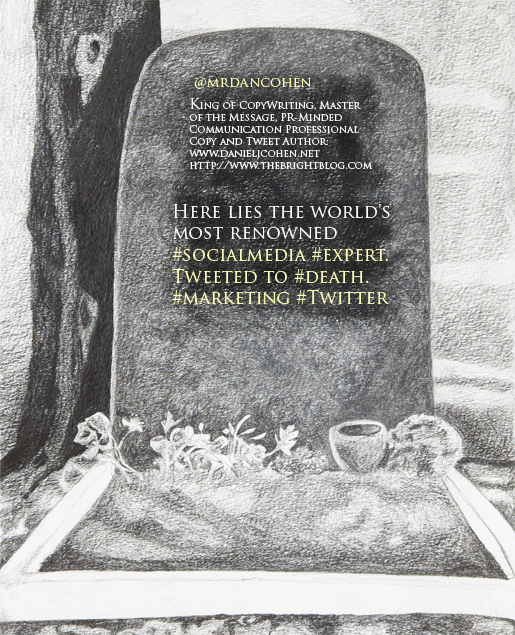Ed: This post originally ran on June 4, 2012. Waxing UnLyrical is on vacation, so we’re re-running it since it’s still relevant… and it’s a great post!
I don’t believe in ghosts.
I know, that seems rather snappy and off-handed to say, so immediately like that, but I don’t. I’m not saying I don’t have views on the universe, spirituality, whatever …
I just don’t believe in ghosts.
So I’m not the kind of guy who says that you will be able to reach out and posthumously communicate with people… unless, of course, I thought that there was really a way to do something like that.
And there is. Sort of.
Call it morbid, but I have always been fascinated by what we leave behind.
There is something about legacy that bridges the gap between two time periods, something that is rarely done.
…
One major existential problem I used to have was that I really would have loved to see how the party developed after I was gone.
One way, it seems, to continue speaking after you pass on is to create a great piece of art. Musicians, authors and visual artists alike all engage in such activity every day, for art is its own mouthpiece on your behalf.
But most art is static. Unless you hire someone to release things in a very particular order with specific instructions after you die, there really is no art project in your name entirely of your nature.
Unless you could, of course, time your messages.
If you’re a clever cookie, you already have figured out the rest of the story at this point:
Social media philosopher ponders how to push his message into the future.
Social media philosopher realizes he does this all the time with business.
Social media philosopher realizes he can schedule messages as far into the future as he likes.
To make it as easy as possible, here it is in steps:
#1: Get Hootsuite and Twitter set up.
#2: Use Hootsuite to schedule messages far into the future.
#3: Live out the rest of your life and let Twitter do the rest.
There you have it; how to tweet after you’re dead. Maybe it won’t be a more evolved version of your psyche, but it will be your messages hitting people in real time.
Non-standard retweets are off the table (unless you REALLY go the extra mile by creating an intricate web of automated retweets, but that just seems stale to me).
…
I thought to myself, “Surely someone must be doing this. I’m into social media and good at what I do, but this isn’t really complicated technology.
“At least some healthy minority of we blogosphere mouthpieces must be using post schedulers, and surely at least a few have thought while scheduling, ”˜I’ll post something three thousand years from now,’ or accidentally hit the wrong key when typing the date and stumbled onto this by accident.”
It turns out that no one really has done it and talked about it. There has been talk of how we should manage profiles of people who pass away, penalizing certain feeds for immoral behavior, even post-death management of your accounts similar to a will.
There’s even a TED talk about the digital Frankenstein that could live after us. There are stories here and there of feeds automatically updating by retweeting on automated settings.
The closest (and you might say actually fulfilling link, in terms of the activity I was really looking for) discusses digital gravestones and final memories for a site … including monthly email videos!
There’s also a site called Death Switch that allows you to send secrets out via email once you have lived out your days.
This was the most important feature: time travel for messages. Anyone can discuss leaving something behind to obscure messages. But staying part of the conversation””building relationships like a living person does””is the part that seems clever to me.
Combine that with true social media outlets such as Twitter, Facebook and WordPress blogs with comments enabled and what have you got?
Tweeting after death.
Imagine the benefits at this point: reminders to your children to grow up well, offering ageless wisdom to the masses … even mentioning ideas you think might otherwise be forgotten.
Guess the format of your message in 3004:
Plan your own 500th Anniversary!
Say hello to your great-great grand daughter!
Heck, you could literally curse people from beyond the grave!
Not that you should, but you could.
…
Now that we know how to tweet posthumously from the technological perspective (wasn’t hard to figure out), we get to the really fun part of the dialogue.
Our messaging.
See, you won’t actually be part of the conversation at this point. At the same time, this is all an exercise in destroying the static.
You’re supposed to be gone, yet you speak. Perhaps people even listen. You won’t be there to defend any controversial statements, or improper predictions.
When you’re wrong, you’re wrong. Just like when you were alive.
Then again, why worry about that? Why even care who doesn’t like you? You aren’t technically alive to emote.
You care now, though, and you are messaging now, too. If you want to talk to the future, I mean really bother to fill out tweets for the next few thousand years, take some pride in doing so.
Technology has finally allowed us to bridge the gap between time and space in a VERY significant way.
It’s only a partial exaggeration to say this is a way to live way beyond your physical mortality.
We should respect that.
So enlighten me: If you had a time capsule that actually acted on your behalf (and remember, you do), how would you manage it?
What messaging should we be sending to the world of tomorrow?
What would you say to the future?
Image: Steven Rosenbaum of SR Graphics (used with permission)









Leave A Comment